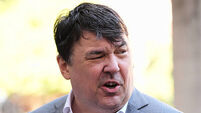The nuclear option: The dangers of a 'nuclear monarch'

What’s scarier? The thought that North Korean dictator Kim Jong Un may be able to blow up a major American city with the press of a button, or that US president Donald Trump has full authority to do the same to any place in the world?
Plenty of people think the latter possibility demands a radical rethinking of how the US might go about launching an apocalyptic, or even “tactical”, nuclear weapon strike.
To get some perspective on the issue, I talked with someone whose entire adult life has been steeped in it: Bruce G. Blair.
Blair is perhaps best known as a co-founder of Global Zero, a non-profit group advocating total abolition of nuclear weapons that has teamed up with not only the expected nonproliferation types but also Republican lions such as former secretaries of state George P. Shultz and James Baker.
But what makes Blair so vital to this debate is that, in the early 1970s, he was an launch-control officer at the Great Plains bases hosting the US Air Force’s nuclear-tipped Minuteman intercontinental ballistic missiles. In other words, an integral cog in the process that could bring about armageddon.
Here is an edited transcript of our discussion:
The protocol calls for the president to be connected to about a dozen top military and civilian advisers, either in person (as in the Situation Room beneath the White House) or by secure phone.
The main talker is the 4-star head of US Strategic Forces, who explains the options (e.g. a nuclear strike plan against N Korea hitting 80 aim points, mostly nuclear forces and associated facilities) and their consequences.
The president may or may not ask others for their advice before picking one. If the conference was prompted by indications of an incoming nuclear attack, then the briefing of the president may not last longer than half a minute, and he may have no more than six minutes to “deliberate”.
If the question at hand is whether to order a first strike, then the discussions could be drawn out for hours or days.
The Pentagon “war room”, headed by a 1-star officer (the officer on duty may be a notch lower in rank, as happened on the morning of the 9/11 attacks), is listening during the exchange, and will require the president to provide a valid identification code (the “biscuit” or Gold Code, which, by the way, several presidents, including Jimmy Carter and Bill Clinton, have misplaced for significant periods) before formatting and transmitting a launch order (the length of a tweet, containing unlock codes and special authorisation codes strictly in the possession of the military) to the executing submarine, land-based missile or bomber crews.
The war room’s job is to quickly execute the president’s order. It only has a couple of minutes to send out the “go code”.
No one else — not even the US secretary of defence, who is nominally a “national command authority” along with the president — plays an active role. No one else need approve the order or confirm that it came from the president prior to its dissemination and implementation.
Trump’s top advisers may not be in the loop at all. The president decides whom to consult, besides himself. It’s all over in minutes. Once the launch order is sent, missiles begin flying out of their silos in the Plains states a minute or two later, and missiles leave their tubes on submarines about 15 minutes later. None can be recalled.
The protocol has not changed in any major way, but I should mention that all presidents from Dwight D. Eisenhower to Ronald Reagan (Kennedy straddled the issue) signed secret instructions delegating nuclear release authority to a raft of generals, in the event of the protocol breaking down under attack.
Whether Trump has signed any such “letters of last resort” in light of growing tensions with Russia is an open question.
Also, different presidents had different ideas about who in the civilian chain of succession should be given the “biscuit”. Under Barack Obama, vice president Joe Biden had a military aide who carried around a briefcase (the so-called “football”) and doubtless also possessed his own “biscuit” for emergency use.

Carter allowed vice president Walter Mondale to carry a “biscuit,” but he withheld such codes from all other successors except possibly the US secretary of
defence.
Standard procedure under plans to maintain the continuity of government during a nuclear war also designates a “sole survivor” from the Cabinet who is protected and equipped to
assume nuclear command if Washington is decapitated.
There were myriad risks of nuclear use run every day — risks of unauthorised or accidental use, mistaken launch on false intelligence or warning, and crises that escalate out of control.
Launching on warning that an enemy strike is under way became an acute concern of mine after the US adopted this policy (notwithstanding the government’s denials) in the early 1970s, followed by the Soviets in the 1980s.
This posed a serious risk of launch on false warning, which nearly happened a couple of times on both sides.
This policy intensified the protocol’s deadlines and danger of a hasty launch decision, a fear illustrated by a 1979 false alarm in which Carter’s national security advisor, Zbigniew Brzezinski, was seconds away from waking Carter at 3am to tell him an all-out Soviet attack was underway and an immediate retaliatory decision was needed.
During my stint, there was one false alarm (in 1973) that put the entire US strategic force on the brink of launch. There were other flabbergasting human mistakes, such as the time that an exercise message calling for a large-scale attack was erroneously retransmitted as an actual launch message.
There are still today hundreds of incidents every year involving US nuclear forces, and now there are nine countries operating nuclear arsenals, and thus nine fallible nuclear monarchs (although Israel’s leader appears to require approval from the security council to use nukes).
Kim Jong Un, Vladimir Putin, Xi Jinping — any of them is perfectly capable making a terribly bad call with nukes. Most of these countries are also far inferior to the US in safety and security standards.

Pakistan’s weapons, for instance, are accidents waiting to happen. And terrorists are trying to get their hands on them.
I used to devote all my efforts to reducing the risks, for instance by pressing for the elimination of “quick-launch” procedures, but 10 years ago realised that the risks will remain unacceptably high unless the world’s arsenals are completely eliminated.
I became convinced that if we fail to achieve global zero in our lifetimes, then their use during our lifetime is inevitable. I was not alone in this belief, and quickly enlisted the support of hundreds of world leaders including most of Reagan’s top security officials to back the movement for Global Zero.
Efforts to reform the checklist-driven launch “protocol” began long ago. (All the nuclear operations from top to bottom of the nuclear chain of command are driven by checklists.)
I and US Senator Sam Nunn and others, decades ago, warned that it allowed too little warning and decision time for any president to reach a rational decision whether and how to use nuclear weapons. The protocol literally railroads him into this when under an apparent attack.
By the same token, it enables the president to railroad the process into executing a decision that may be ill-advised, impetuous, and reckless.
It is true that Trump’s candidacy and election threw a spotlight on this particular deficiency and inspired many to seek new ways to strengthen safeguards on nuclear decision-making.
At other times in our history, steps have been quietly taken by insiders to insulate the protocol from rash presidential orders — as when defence secretary James Schlesinger and secretary of state Henry Kissinger instructed the Pentagon war room to check with them first before carrying out any orders from President Richard Nixon.
Now it’s all out in the open, and a long-overdue debate has begun about the danger of having a nuclear monarch in the Oval Office.
Trump is Exhibit A, because of his character and history. Under the military’s personnel reliability rules, he would never be eligible for access to nuclear weapons if he were subjected to them.
Not at all. All presidents, no matter how calm, rational, and seasoned they may normally seem, have their moments of poor judgment and emotionally charged decision-making, and I cannot think of a situation that cries out more for more consultation and more time and information than one in which the first or second use of nukes is under consideration.
The established emergency protocol in practice already involves these generals and Pentagon leaders, as well as many other senior officials — even though their participation has not been legislated and could be altered at any time by a sitting president.
Nobody has complained that it is too sluggish or that it even precludes launch- on-warning during the 15- or 30-minute flight times of enemy missiles.
In my view, the entire process needs to be slowed down and made more consensual, especially in the case of an apparent imminent existential threat that may be too easily misinterpreted by one all-powerful person, who may too quickly seize upon nuclear weapons as the solution.
In fact, I have yet to find any such threat that warrants the first use of nuclear weapons in a pre-emptive, much less preventive strike.
No one has ever put forward a persuasive case for using US nukes first in light of the marginal benefits, the alternative non-nuclear means at our disposal, and the large costs and risks that nuclear use would end in large-scale catastrophe for everyone.
In most scenarios, using nukes first also violates the laws of war and the UN charter. The exception that self-defence would necessitate a pre-emptive strike against an enemy committed to attack us is bound to require careful assessment.
We should not want any one person to render this judgment and have the power to enforce it, especially one lacking in experience and knowledge in international security affairs.
The US president and the vice president should approve the second use of nuclear weapons in situations of confirmed nuclear attack against the US.
If the nuclear command and control system collapses under attack and cannot be reconstituted with these authorities in command, then the protocol should allow reliable and fairly rapid devolution down the chain of succession until the next two successors can be installed.
For situations involving first use of US nuclear weapons, a consensus of six individuals should be required — the president, vice-president, speaker of the House, Senate leader (pro tem), national security adviser, and secretary of defence.
The first four in that order represent the legal chain of presidential succession, and involve senior congressional as well as executive branch officials to provide balance and broad political legitimacy.
I and all US military officers swore an oath to defend the US Constitution. Perhaps because this document stipulates in Article 2 that the president is the commander in chief of the armed forces, the oath implies fealty to the president.
But the oath certainly explicitly refers to the Constitution, which in turn gives Congress
(Article 1) the right to declare war. I will let the lawyers brawl over whether strengthening safeguards on nuclear decision-making runs afoul of the Constitution.
I would never today swear an oath to obey the nuclear orders of this president unless he were subject to firm checks and balances. Trump is unfit to be commander in chief and he himself poses a clear and present existential threat to the Republic.

Things had gotten really bad. I keep in touch with launch officers who recently served, and am told that life and work are better — less micromanagement, relief from testing hell, cleaned-up facilities, better equipment, etc.
And sense of mission has increased in view of deteriorating relations with Russia and loggerheads with North Korea.
Nuclear war is back in the air after nearly three decades, and senior officials are showing their nuclear bare knuckles.
Notwithstanding the image painted by Secretary of Defence Jim Mattis of the missile forces sponging up enemy warheads (not a mission anyone can lovingly embrace), this newfound attention boosts the crews’ morale, even if it represents a setback in reducing the salience of nuclear weapons in international relations.
Still, the forces are aging and the Air Force will never value the missile crews the way it reveres airplanes.
The sacred cows in the Air Force today are the new bomber, new tanker, and new fighter.
Silo-based missiles may get a reprieve for a while but they are on the chopping block and no one entering the Air Force can imagine a strong career in missiles for the next 30 years.
This is not a recipe for sustaining high morale. It’s no wonder that the vast majority of missile launch officers are drafted involuntarily into the assignment.
Obama nailed the vision and the oratory, but he failed to give marching orders to his bureaucracy to devise a serious plan leading to the elimination of nuclear weapons.
So of course the bureaucrats did what they do best: Turn good proposals into mush and preserve the status quo at all costs.
Obama’s lack of strong governance in this arena is illustrated by his 2013 nuclear-employment guidance, which missed the boat for eliminating launch-on-warning, rejecting the first use of nuclear weapons, and abjuring the war-fighting strategy that continues today to dominate the work of US targeteers.
In fact, the guidance boosted the aim of destroying the nuclear forces of Russia, China, and North Korea in wartime. Barack Obama’s policies have done nothing to strengthen strategic stability.

He would have pursued further cuts in US and Russian arsenals, however, if only his counterpart had been more co-operative. He was on the right track in this sense.
As for the trillion dollars, the amount itself is not so important - it represents 4% of the current US stock market capitalisation — as the misallocation it represents.
We should be eliminating the “use or lose” land-based missile force which must be launched first or quickly on warning to survive. We don’t need this leg of the triad.
The US Trident submarine force alone can cover all the core deterrence aimpoints of leadership and economic targets in Russia and China combined.
The land missile force adds a few hundred weapons to the game of war-fighting. Its funding should be redirected into nuclear command, control, and communications.
This system remains vulnerable and prone to collapse under the weight of even small attacks, and is increasingly infected with malware that could derange its performance and cause a mistaken launch.
This vulnerability is one key reason the protocol for nuclear decision-making drives a president to acquiesce to the imperative of speed in authorising release. It is a deficiency that limits our options for strengthening checks and balances on nuclear decision-making.
















